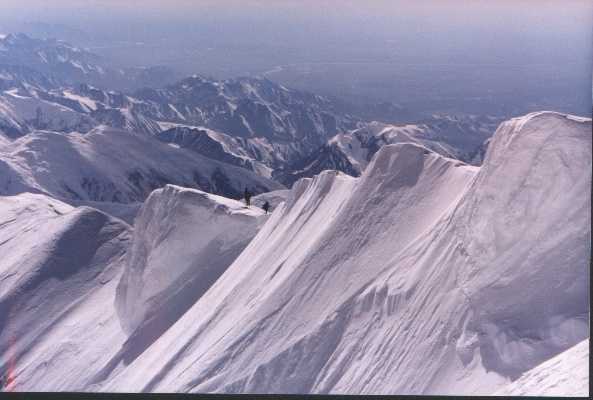Denali 99, J.S. Milne
For many years I have been attracted by Denali (20,320 feet; highest peak in North America), but the crevasses below 14,200 feet make it dangerous for soloing. This year I went with one other person, Pete Downie, on the West Buttress route. Below 14,200 feet we climbed together; above, effectively, we soloed.Day 0. (June 2, 1999). Pete and I were stuck in the village of Talkeetna by bad weather, waiting for a flight into the Kahiltna glacier.
Day 1. (June 3). We flew into the Kahiltna glacier at 7200 feet, and sledded/carried all gear to a camp at about 7800 feet. With 22 days food, climbing gear, and enough clothing and camping gear to survive a major storm, I had about 100 lbs. Pete had even more.
The Park advises parties not to attempt to reach the summit in less than 14 days (because of the altitude) and guided parties take at least 17. We were hoping to do it in less, but the weather on Denali is notoriously bad, whence the extra food. The forecasts before we left were for temperatures of minus 35 degrees (F) and winds of 60 mph on the summit.
The first night, the temperature was 8 degrees at our campsite.

Day 2. We single sledded (i.e., moved with all our gear and food) to a camp at 9000 ft on the glacier. During the night the wind blew so much snow that Pete's tent would have been buried if he hadn't spent part of the night digging it out.
Day 3. We single sledded to 10,500 ft.


Day 4. We hauled a load to 12,500 ft, and cached it; returned to 10,500 ft.
Day 5. We moved camp to 14,200 ft.


Day 6. We returned and picked up the cache from 12,500 ft.
Day 7. We rested and acclimatized in mediocre weather at 14,200 ft.
Day 8. Carried a load to the 17,200 ft camp, and returned to the 14,200 ft camp.

Day 9. Moved camp from 14,200 ft to 17,200 ft. I passed many climbers on the climb, and reached the campsite first, thereby securing the best fort (campsite with snow walls to protect against winds, built by previous climbers). Pete came up later in the day and shared the fort.
Day 10. I left for the summit from the 17,200 ft camp before everyone else, and had the mountain to myself until I met two Australians who were camping at 19,500 ft after an ascent of the West Rib. The summit ridge had a snow plume, and the Aussies warned me it could be difficult in a high wind. I climbed to the ridge, and was struck by a powerful southerly wind blowing across the ridge. After I had traversed about 50 feet of the summit ridge it became necessary to walk on top of the narrow (inches wide) snow/ice ridge. Because of the buffeting by the wind, this was too dangerous without the rope, and so I was forced to abandon the climb only 150 feet below the summit. To add to my chagrin, the wind dropped later, and when other climbers (including Pete) reached the summit ridge later in the day, it presented no difficulties.
Day 11. Yet another fine day, and so I set off once more for the summit. This time there were climbers ahead of me. I passed all but one on the climb to Denali pass, and caught the last just 50 feet before the top. By a remarkable coincidence, he was a young New Zealander from Queenstown (where I spent all my holidays in my youth) who had started his climb from the 14,200 ft camp. For 20 minutes, the highest point in the United States was occupied by two Kiwis. Without the strong cross wind of the day before, traversing the summit ridge was pure delight.





According to one guide book, the usual time for the trip from the 17,200 camp to the summit and back is 8--12 hours, and according to the other it is 10--15 hours. Most parties were taking over 10 hours and returning exhausted. I had taken 6 1/4 hours.
While we were at the 17,200 camp, one member of a party of three suffered from altitude sickness while attempting the summit. On the descent, he fell, pulling another climber with him, on the dangerous snow/ice slope between the camp and Denali Pass. Fortunately, the third member saved the group.
Day 12. Pete and I descended to the 14,200 ft camp and collected our sleds. Because of careless packing, both of us had many problems with sled rollovers on the way down, but we reached the 11,000 ft campsite late.




Day 13. We were up early, and reached the Kahiltna base about 2:30. The crevasses were much more dangerous than on the way up, and I put one foot down a very big hole. A party before us said they "slotted" twice, despite wearing snowshoes. The base camp representative radioed for a plane, and we were back in Talkeetna by about 4pm (that's the Alaskan way).

The weather turned mediocre as soon as we got out, and within a week there were 4 feet of new snow on the upper part of the mountain. News. By the start of July, the snow bridges on the lower part of the mountain were collapsing at an alarming rate. News
It had been a very intense trip. The route is continuously interesting, with spectacularly beautiful views the whole way. Because of the hazards from crevasses, the altitude, the Arctic weather, and the long sections where a fall can be fatal, it is very serious. The days spent soloing above 14,200 were among the best of my life.
Copyright 1999 J.S.Milne.